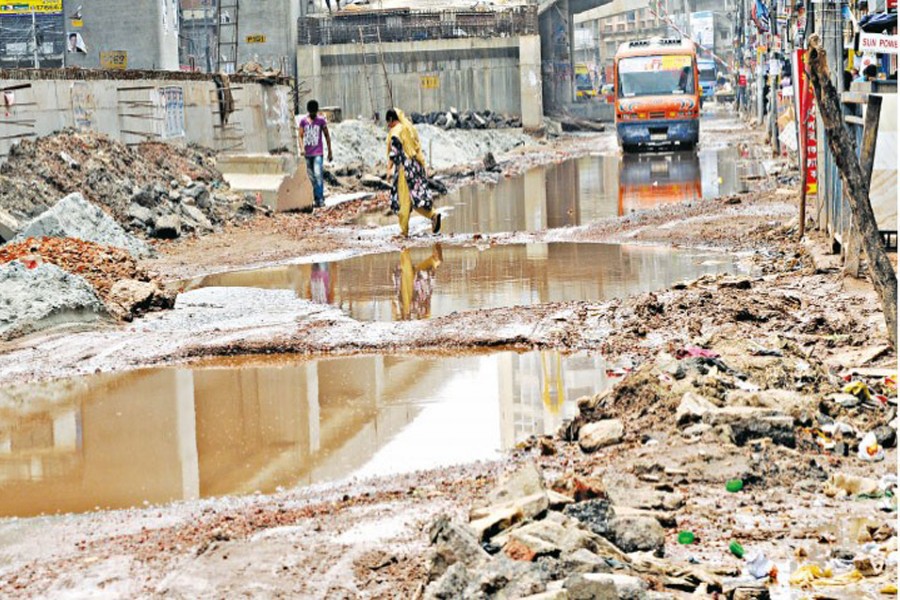The sudden rainstorm that lashed out at Dhaka at dawn recently stands out with noticeable features. It did not occur in accordance with the normal Bangla seasonal pattern. The month being Falgoon, the time would have seen a mild post-winter temperate weather, punctuated by brief spells of shower. Secondly, rains that immediately follow winter in Dhaka are light in terms of intensity. They hardly create water-logging, or cause disruptions to day-to-day urban chores. But the rainstorm that assailed Dhaka on February 17, took the city-dwellers off-guard; many were seen becoming apprehensive of the travails of moving through submerged roads filled with muddy, viscous water. This dread stemmed from the shambolic condition in which many parts and intersections of the city's roads have been left amid the ongoing metro rail works. Normal digging of trenches for repairing various types of utility service lines was also feared to add to the sufferings of the pedestrians this year.
With piled-up loose soil kept beside the stretches dug out turning into heaps of mud, mixed with bricks and brick chips, the roads became difficult to use only temporarily during the recent rainstorm. But the spectre of sufferings apparently lies ahead. The rain-time ordeal due to road construction and repair works has long been an annual ritual for the city dwellers. They have accepted it as part of their urban life. During summer, the road-related digging works continue to create the dust menace for the people, be they pedestrians, rickshaw or auto-rickshaw travellers. With the start of the rainy season, the scenario takes another ugly turn. The omnipresent dust becomes all mud. In place of the hazardous air, the menace this time grows on the ground. It may not cause spread of viruses, but it does lead to physical trouble and discomfort for the general people in the densely populated city. Water filled with municipal waste and myriad types of urban garbage turns many areas partly or completely unfit for walking during rains. Some dug-out areas lurking under water become hazardous. Long-time residents of the capital have started bracing for the difficulties that might mar their movement during the rains this year. In the coming monsoon pits, dug out for installing metro rail viaducts on columns, and building infrastructure, like stations and their stairs, are set to worsen the road condition. Urban experts have been calling upon the relevant authorities since beginning to keep alternative routes for movement of vehicles and pedestrians. Scattered arrangements for stop-gap use are seen being in place in parts of the city. But they are untidily set up. Dhaka needs alternative arrangements which will last during the whole time of metro route construction.
Had the recent rainstorm-battered day continued into late morning on February 17, the Dhaka residents would have passed through the year's first bout of miseries. Fortunately, they were spared. Despite being cloudy, inclement weather did not disrupt life in the capital in the following days. But there is not much scope to remain complacent. In the last few years, people in Bangladesh have started becoming used to witnessing rainstorms and tornadoes in February-March, ahead of the time when they would make their onslaughts in the past. With the work on metro rail routes in full swing in a vast swathe of the capital, lots of people are overtaken by the dread of multiple sufferings. After all, the record of smoothly implementing a grand project in Dhaka is not pleasant, if not bleak. The hiccup-laden construction of flyovers in the city, especially in its northern part, is a case in point. According to urban experts, the ongoing mega plan of putting in place a modern and efficient metro railway network in Dhaka suffers from a lot of gaps. The most prominent of them is not keeping provisions for temporary roads and sidewalks during execution of the project. Few believe, not unreasonably, that the first phase of the metro rail project could be completed within its scheduled time. Moreover, in an attempt to add to the breadth of the railway network, the authorities have decided to launch the MRT (Mass Rapid Transit)-1 alongside completing the MRT-6. Covering a distance of 20.10 kilometres, MRT-6 will connect Uttara with Motijheel, while MRT-1 will cover another vast area as it will link Dhaka Airport with Kamalapur and has the provision for a branch line (Notun Bazar-Purbachal). MRT-1 will accommodate both overhead and underground (subway) tracks.
The vast range of work, comprising two modes of rail transport, is feared to cause unwarranted delays to the completion of the project. With the past experiences in view, one cannot rule out the likelihood of the projects dragging behind schedule, and concomitant increase in people's sufferings. In the apprehended case of slipshod progress in the metro rail work, the spectre of sufferings in all modes of road movement looms large. If not executed in a planned way, especially during monsoon, disruptions to normal city life might make the metro rail project appear veritably to be a nightmare. However, it's undeniable that after the completion of the metro routes, almost all the areas in the city are expected to be interconnected, with the distances shortened radically.
At present, the majority of road digging work in Dhaka is being carried out by the MRT authorities. Given the great changes they will hopefully bring about in Dhaka's communication, people are looking forward to the prompt completion of the metro rail work. They are prepared to bear with phases of inconvenience. But those should not be tinged with prolonged sufferings, which can largely be avoided by adopting a planned style of work.


